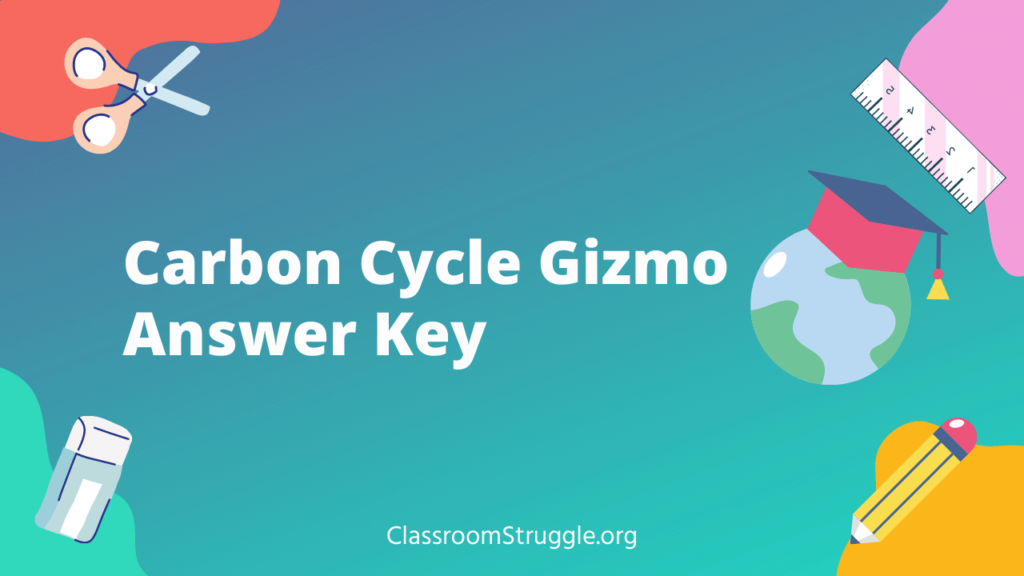Are you looking to get FREE answer key for Carbon Cycle Gizmo questions? If YES, check below for solutions.
Hope you gonna like it for sure.

Carbon Cycle Gizmo Answer Key
NOTE: All answers are checked twice before publishing them to you. So, please share if it helps you.
Student Exploration Carbon Cycle
Vocabulary: atmosphere, biomass, biosphere, carbon reservoir, carbon sink, fossil fuel, geosphere, greenhouse gas, hydrosphere, lithosphere, photosynthesis
Prior Knowledge Questions (Do these BEFORE using the Gizmo.)
In the process of photosynthesis, plants intake carbon dioxide (CO2) from the atmosphere & water (H2O) from the soil. Using the energy of sunlight, plants build molecules of glucose (C6H12O6) & oxygen (O2). (You can find all the answers in green color below)
Q.1. How do plants on Earth affect the amount of carbon in Earth’s atmosphere?
Ans: Plants take in carbon dioxide (co2) and process it into oxygen(o2).
Q.2. Animals eat plants and produce carbon dioxide and How do animals affect the amount of carbon in Earth’s atmosphere?
Ans: They eat plants that process carbon dioxide & when they eat these plants, there are fewer plants that can process the carbon dioxide.
Gizmo Warm-Up

Q.1. From Earth’s atmosphere, where can the carbon atom go next?
Ans: Oceanic Co2, land plants, & exposed rock.
Q.2. Click on Land plants and read the description (at the bottom of the simulation). How did the carbon atom get from the atmosphere to a plant?
Ans: Plants use energy from the sun for photosynthesis. Most of the oxygen is released.
Q.3. Select Land animals. How did the carbon atom get from land plants into the animal (read the description )?
Ans: Land animals consume plants for energy.
Q.4. Select Atmospheric CO2. How did the carbon atom get from land animals back to the atmosphere?
Ans: They release carbon dioxide back into the atmosphere through cellular respiration.
Carbon Cycle Gizmo Answer Key Activity A

Introduction: Earth can be divided into 4 systems. The atmosphere is the air above Earth’s surface. The hydrosphere is composed of all of Earth’s water. The geosphere is the rocky, non-living part of Earth. The biosphere consists of all living things, including us. Few scientists use the term “anthroposphere” to describe everything made or modified by humans.
Question: How does carbon move between the atmosphere, hydrosphere, biosphere, and geosphere?
Q. 1. Explore: Use the Gizmo to create a path for carbon (7 steps total) that begins and ends in the atmosphere. Fill in the steps in the path below. Then, summarize very briefly how the carbon atom got to that

Ans:
Q. 2. Create: Click Reset. Use the Gizmo to create a path in which the carbon atom goes from the atmosphere to the hydrosphere, biosphere, and geosphere (see the definitions at the beginning of Activity A). Describe each transition

Ans:
Q. 3. Explore: Use the Gizmo to create three more (different) carbon paths, each starting and ending in the atmosphere. Label each location with A for atmosphere, B for biosphere, G for geosphere, or H for:
Ans:
Path 1: Atmosphere: A – Oceanic Co2: H – Atmosphere: A
Path 2: Atmosphere: A – Land Plants: B – Coal: B – Power Plant: B – Atmosphere: A
Path 3: Atmosphere: A – Land Plants: B – Land Animals: B – Atmosphere: A
Q. 4. Explain: Based on the Gizmo, explain how the following transitions might take place:
A) Describe at least two ways that carbon can get from a land plant to the
Ans: It can get there from forest fires and land animals. When the plants burn in a forest fire, the fumes are carbon dioxide. When land animals breathe, they exhale carbon dioxide which is filtered back into the atmosphere.
B) Describe at least two ways that carbon can get from the atmosphere to the hydrosphere.
Ans: It can go straight to the hydrosphere or go through the exposed rock to the hydrosphere. Carbon goes into oceanic Co2 by being dissolved by the cold waters. The exposed rock used carbon by dissolving it into the water. It goes into oceanic Co2 by the rainwater breaking it down.
C) Describe two ways that carbon can get from the ocean to the lithosphere. (The lithosphere is the rigid layer of the Earth, including the crust and part of the)
Ans: It can go from the shells to the limestone & also to the lithosphere. It can also go from marine plants to marine animals to the sediments & finally to the lithosphere. The sediments & limestone, over time, are broken and packed down to create the lithosphere.
D) Explain at least two ways that carbon can get from seashells to the
Ans: It can go through the shells to the limestone & also to the lithosphere then to the volcano & to the atmosphere. It can also go from the shells to the limestone to the cement plant to the atmosphere.
Carbon Cycle Gizmo Answer Key Activity B

Introduction: Fossil fuels, such as coal, oil, & natural gas, formed over millions of years from the remains of ancient plants & animals. The burning of fossil fuels, as well as other human activities, increases the amount of carbon dioxide(Co2) in the atmosphere.
Question: How does human activity affect the carbon cycle?
Q. 1. Describe: Using the Gizmo, determine how coal and petroleum (oil) are Describe the steps required to form each fuel from atmospheric CO2.
Ans:
Coal: It goes from the atmosphere to plants in photosynthesis. When the plant is compressed after it dies, coal is formed.
Petroleum: It goes from the atmosphere to plants in photosynthesis. The plant goes to soil and to sediments. Then it goes into petroleum.
Q. 2. Explore: Natural gas is a mixture of methane (CH4), ethane (C2H6), and other gases. How is the formation of natural gas related to the formation of coal & petroleum?
Ans: The formation of natural gas is related to the formation of coal and petroleum because they are both made from the same thing and one of our ways of fuel. They both produce carbon dioxide when being used for fuel.
Q. 3. Describe: Fossil fuels are used in many Using the Gizmo, describe the main use for each fuel.
Ans:
Coal: The main use is electricity generation.
Petroleum: Petroleum is mainly used for transportation fuel. Natural gas: Natural gas is mainly used as a source of energy.
Q. 4. In each of the above cases, what is the end product of burning fossil fuel, and where does it go?
Ans: When we burn fossil fuels, it always makes Co2. The Co2 goes into the atmosphere. It always ends up in to the atmosphere.
Q. 5. Explore: Another major contribution to atmospheric carbon dioxide is the cement industry. Using the Gizmo, find and list a carbon atom path from the atmosphere to the cement plant. (Hint: One of the ingredients in cement is )
Ans: Path: Atmosphere-Ocean Co2 – Shells/Coral – Limestone – Cement Plant
Q. 6. How is carbon dioxide produced in a cement plant?
Ans: During the process of making cement, the cement plant produces carbon dioxide.
Q. 7. Analyze: Click Reset, then navigate to the Land animals. Select Atmospheric CH4.
A) How do land animals create methane?
Ans: Bacteria break down undigested materials and produce methane gas. When they eat plants, they are transferring the carbon from the plants to themselves. When they eat, they create waste and this waste produces methane.
B) Humans raise large numbers of cattle for How will these herds of cows affect Earth’s atmosphere?
Ans: They produce large amounts of methane gas into the atmosphere.
Q. 8. Analyze: In many tropical rainforests, people clear land by cutting down trees and burning them. After a few years, the soil runs out of nutrients and cannot be farmed any How does this practice of “slash and burn agriculture” affect Earth’s atmosphere?
Ans: This releases large amounts of carbon dioxide into the atmosphere. Also, since there are fewer trees, it is harder for them to process the carbon dioxide.
Q. 9. Draw conclusions: In general, how do, many human activities influence the carbon cycle?
Ans: We use coal & petroleum as resources & then once we burn them, they form carbon dioxide(Co2). We drive our cars, fuel our houses, and many other resources. We, as a society produce a large amount of Co2 & it is not always turned back into oxygen by plants due to many factors. This greatly impacts the amount of Co2 in the atmosphere because rather than being turned back into oxygen(O2), it remains Co2. This ends up polluting our oxygen in every manner.
Carbon Cycle Gizmo Activity C

Introduction: We all know that humans have been burning fossil fuels rapidly for the past 250 years. As a result, the amount of atmospheric carbon dioxide(Co2) has increased by about 40% since the year 1800. By measuring how much carbon moves in & out of the atmosphere, now scientists can predict the change in the amount of atmospheric Co2 every year.
Question: How can we model changes in atmospheric carbon over time?
Q. 1. Observe: The MODEL tab shows a simplified model of the carbon cycle. The ovals represent carbon reservoirs, where carbon is The unit “GtC” stands for gigatonnes of carbon, where one GtC is equal to one trillion kilograms of carbon. The arrows represent how much carbon moves from one reservoir to another each year, in gigatonnes per year.
A) Look at the arrows pointing toward atmospheric CO2. What are the two major sources of atmospheric carbon?
Ans: Natural & human activities.
B) A carbon sink is a location that stores carbon for a long period of time. Which two carbon sinks remove carbon from the atmosphere?
Ans: Oceans & plants.
C) Without changing the Gizmo, list the carbon reservoirs from largest to smallest.
Ans: Atmosphere->Terrestrial biosphere->Oceans->Fossil fuels
Note: The largest carbon reservoir is considered to be Earth’s lithosphere, which contains about 80,000 GtC. But, there is not much exchange between the lithosphere & the other reservoirs on short time scales.
Q. 2. Calculate: Carbon dioxide is a greenhouse gas that helps to trap heat in Earth’s atmosphere. We need some CO2 in the atmosphere to maintain a warm planet, but excess carbon can cause considerable warming of the planet.
A) What fossil fuel usage will result in no change in atmospheric CO2 each year?
Ans: Carbon dioxide (Co2)
Q. 3. Experiment: Using the Gizmo model, explore the following questions:
B) How does increasing plant biomass (amount of plants) affect atmospheric CO2?
Ans: Conceptual diagram outlining important plant responses to higher concentrations of Carbon dioxide(CO2) in the atmosphere.
C) How does increasing oceanic CO2 intake affect atmospheric CO2 and oceanic CO2?
Ans: The ocean would continue to soak up more & more carbon dioxide(Co2) until global warming heated the ocean enough to slow down ocean circulation.
Q. 4. Think about it: Since hard-shelled organisms evolved about 550 million years ago, billions of tons of limestone rock have been produced from their shells. Limestone is made of calcium carbonate, with the formula CaCO3. Based on this, how do you think the amount of atmospheric CO2 has changed in the last 550 million years, & how has this affected Earth’s climate? Explain your answer.
Ans: Carbon dioxide(Co2) has decreased over the last 200 million years only because of speeding up of the passage of carbon atoms from their volcanic sources into sediments.
About Gizmo
Gizmo presents you with the best STEM learning tools for the students. Its easy interface allows its students to deal with real-time concepts. Their concepts include analyzing the data, measuring, comparing results from successful experiments.
Gizmo follows the latest educational standards & assessments. They work well on PCs, Macs, Android devices & even on iPads.
contact: [email protected]
Hope you got access to Carbon Cycle Gizmo Answer Key for levels A, B & C by following our above solutions. Share with other students if you find it helpful.



